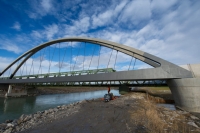St. Margrethen - Lauterach Railway Line, Section km 0,749 bis km 2,663
Client: Austrian Railways Infrastructure AG
Development Period: 2004 to 2013
In the course of the development of the railway line St. Margreten - Lauterach, the flood-proof in the vicinity of the Rhine has been improved. This required the reconstruction of the bridge across the Rhine and the raising of the complete route by 2.0 m. For this reason, seven more bridges (on Swiss and Austrian side) also had to be rebuilt.
The 276 m long, 7-span Rhine Bridge was built as a reinforced concrete - steel composite structure with steel main and end cross girders as well as a cast-in-place concrete trough. The main bearing structure across the Rhine has a span of 102 m and is hung down from an overarching bow with a height of 20 m.
The new route was established at a distance of 12 m beside the previous track. The relocation of the operating route was carried out during a seven week closure.
BGG Consult was commissioned for this project with the geotechnical and hydrogeological consulting since the beginning of the planning. Furthermore, extensive geotechnical services and investigations were done regarding the existing embankments accompanying the Rhine for the International Rhine Regulation Agency.
After planning, supervision and evaluation of subsoil investigations and soil physical laboratory analyses, a Geotechnical and a Hydrogeological Expert's Report for the complete route and the bridges were compiled. Subsequently, the tendering and finally the construction itself were accompanied with regard to geotechnics and hydrogeology.
Foundation of the Rhine Bridge:
From a geological point of view, the surrounding area of the Rhine Bridge can be assigned to the quarternary deposits of the Lake Constance. Only close to the surface, stratigraphic members of sand or gravel with fluviatile origin exist. Below, fine-grained materials (lacustrine clay) with unfavourable bearing and deformation characteristics are found down to a depth of several hundred metres. With increasing depth, the bearing capacity decreases significantly.
For the foundation of the bridge and the column piers, cast-in-place concrete bored piles (Ø 90 cm) were used. The unfavourable influence of the lower underground had to be considered especially with regard to bearing capacity, creeping behaviour and pile group effects.
November 2013
